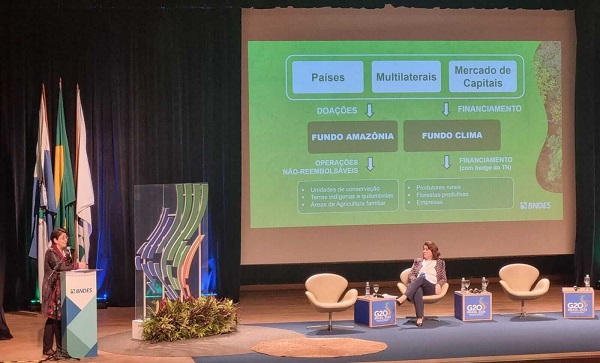 Focused on capturing carbon from the atmosphere and reforesting the Amazon, the BNDES detailed the “Arc of Restoration” project during “States of the Future”, a G20 side event. Divided into two phases, the project aims to capture 1.65 billion tons of carbon from the atmosphere by 2030.
Focused on capturing carbon from the atmosphere and reforesting the Amazon, the BNDES detailed the “Arc of Restoration” project during “States of the Future”, a G20 side event. Divided into two phases, the project aims to capture 1.65 billion tons of carbon from the atmosphere by 2030.
Imagine, in 30 years, reforesting an area of 24 million hectares – the equivalent to the state of São Paulo. This is the goal of the “Arc of Restoration” project, presented by the Brazilian National Bank for Economic and Social Development (Banco Nacional de Desenvolvimento Econômico e Social do Brasil /BNDES) during the States of the Future, a G20 side event held in Rio de Janeiro in July. The challenge is to reforest the area of the Amazon now known as the “Arc of Deforestation”, a region that spans the eastern and southern parts of Pará, as well as Mato Grosso, Rondônia, and Acre. This area has the highest rates of deforestation in the Amazon.
The goal is to replant the destroyed forest and thereby capture carbon from the atmosphere through the process of photosynthesis — the production of energy by the trees, returning oxygen to the environment. According to the BNDES, it would be possible to remove 1.65 billion tons of carbon from the atmosphere in 30 years. In all, the project is expected to impact more than 50 municipalities.
Investment needed
According to Tereza Campello, socio-environmental director at BNDES, the project will require around BRL 204 billion. The work is expected to be divided into two phases: the first, which will run until 2030, involves the restoration of priority areas totaling around 6 million hectares. This stage would require an investment of BRL 51 billion. The second phase will run from 2030 to 2050, with an additional 18 million hectares restored through the investment of another BRL 153 billion.
Brasil has already invested BRL 1 billion into the initiative through two funds: the Amazon Fund, which raises resources from governments and public and private institutions, overseen by the BNDES; and the bank’s own Climate Fund. This transfer is considered the first step in the recently launched Arc of Restoration.
Project monitoring structure
The BNDES has also structured the processes that will monitor what is being spent and the measurement of the amount of carbon stored, Campello informed. “We intend to organize a platform dedicated to this process. We are talking about medium- and long-term measures, so learning from this process will also be very important.”
In a joint initiative with Brasil’s Ministry of the Environment and Climate Change (Ministério do Meio Ambiente e Mudança Climática do Brasil /MMA), the BNDES recently launched the Restaura Amazônia notice, the first call for bids for the Arc of Restoration. The states were divided into three macro-regions, covering all the states in the Arc of Deforestation as well as Amazonas and Tocantins. The winning institutions of this call have already been announced.
Impact of the Arc of Restoration
Campello underscored that the area was chosen for this reforestation because, in addition to helping to curb regional deforestation, it is also strategic from a scientific point of view. “This is not about planting a bunch of trees. Firstly, because it would not be on a scale, and secondly, because from a biological point of view, having a native forest [in the case of the Arc region] or having a pine forest [reforestation in areas where there was no forest] has completely different impacts.”
The mere existence of tropical rainforests such as the Amazon has already reduced the world’s temperature by 1°C, according to research by scientist Deborah Lawrence, from the University of Virginia (USA). The report was published in the Frontiers in Forests and Global Change Journal (Fronteiras em Florestas e Mudança Global). Although this reduction may seem small, this cooling of around 1°C represents half of what the Paris Agreement foresees as the average temperature increase by the end of the century, which is below 2°C.
With reforestation in an area of native forest, nature also regenerates itself. This can happen by isolating the area without deforestation and preserving biodiversity on site, combined with reforestation, preservation, and control of the surroundings actions. “If we can get the restoration process to begin, it will be easier to regenerate because the forest is right next to the site and it will feed the restoration process. It is more strategic because it will be faster there than anywhere else,” she explained.
At States of The Future, Campello stressed that the BNDES initiative is not a substitute for other ways of mitigating climate problems, but rather an innovative ally. “There is no technology installed in the world today on a scale to capture carbon to carry out this task,” she explained. She details that the project is an example for the world, and sums up how the bank wants to be seen. “We see ourselves here as promoters of development and the law”.
Leandro de Deus, a professor in the Physical Geography department at Uerj, says that the bank’s initiative is extremely valid for combating climate change – especially if combined with other actions – but that any interventions in space should be made in consultation with society. He points out that the importance of this participation is even greater if we take into account the indigenous and quilombola areas that could be affected by the restoration of vegetation.
Campello, from the BNDES, says that the project can also help protect and preserve indigenous and quilombola areas. “Today we have the most sensitive areas, such as Indigenous lands, Quilombola lands, and conservation units, many of which are at risk today from land grabbing, so anything we can use to ensure zero deforestation and restore these territories is fundamental for us,” he explains.



